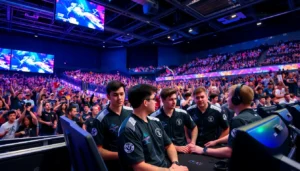Table of Contents
ToggleIn a world where every dungeon crawl feels like a walk in the park, roguelike RPGs turn that stroll into a chaotic rollercoaster ride. Picture this: one moment, you’re slaying monsters and hoarding treasures, and the next, you trip over a banana peel and find yourself face-to-face with a dragon. It’s this unpredictable thrill that keeps players coming back for more, eager to dive into the next adventure.
Overview of Roguelike RPGs
Roguelike RPGs offer players a unique blend of unpredictability and adventure. They redefine dungeon crawling, ensuring that each session presents new challenges and surprises.
Defining Roguelike RPGs
Roguelike RPGs are turn-based games characterized by randomly generated environments. Players navigate these environments, making choices that shape their fate. With permadeath as a central mechanic, characters face permanent consequences. Each attempt presents players with new layouts, enemies, and items, creating a sense of freshness with every run. The genre takes inspiration from classic games like Rogue, emphasizing strategy and exploration.
Key Characteristics
Key characteristics of roguelike RPGs include procedural generation and permadeath. Procedural generation ensures that no two sessions play out the same, enhancing replayability. Permadeath adds tension, as players must approach each encounter with caution. Randomized loot and events present further surprises, contributing to the thrill of discovery. Players often encounter various classes and abilities, allowing for diverse gameplay strategies. These elements combine to create an engaging experience that keeps players returning for more.
Popular Roguelike RPGs

Several roguelike RPGs stand out for their unique mechanics and engaging gameplay. Each game offers distinct experiences that draw players back for more adventures.
Game 1: An In-Depth Review
Hades captivates players through its fast-paced combat and rich narrative. Set in the underworld, players control Zagreus as he attempts to escape Hades’ realm. Each attempt features procedural generation, ensuring that no two runs are the same. Character interactions deepen the story with every playthrough, making it enjoyable to uncover different endings. Hades blends action and role-playing elements expertly, resulting in a thrilling experience.
Game 2: An In-Depth Review
Dead Cells combines roguelike and Metroidvania elements seamlessly. Players navigate a constantly changing castle while battling enemies and collecting upgrades. The combat system feels fluid and responsive, allowing for various playstyles. Each death provides learning opportunities, leading to improved strategies for future sessions. Randomly generated levels encourage exploration and experimentation, keeping gameplay fresh and exciting.
Game 3: An In-Depth Review
Slay the Spire innovates the genre with its deck-building mechanics. Players choose from various characters, each with unique abilities and cards. Decisions significantly impact the game’s outcome, as players face random events and challenging foes. The combination of strategic planning and chance creates a dynamic gameplay loop that appeals to both casual and hardcore gamers. Every attempt to reach the spire presents new and unexpected challenges, fostering continued engagement.
Gameplay Mechanics of Roguelike RPGs
Roguelike RPGs feature distinctive gameplay mechanics that enhance player engagement and foster replayability. These elements create unique experiences in every session.
Permadeath and Its Impact
Permadeath significantly alters the stakes in roguelike RPGs. Players face permanent character loss after dying, which intensifies emotional investments in characters. The consequence of losing progress heightens tension, compelling players to think strategically before each action. This mechanic encourages calculated risk-taking, as players fear losing hard-earned progress. An absence of respawns forces focus on careful exploration rather than reckless play. This unique element drives the thrill, making every encounter feel crucial in the quest for survival.
Procedural Generation Explained
Procedural generation serves as a cornerstone of roguelike RPGs, providing an unpredictable gameplay experience. Each playthrough features randomly created levels, ensuring no two runs feel alike. This randomness keeps players engaged, as they always face new challenges and surprises. Dungeons, enemies, and items change with each attempt, enhancing replayability. Additionally, this mechanic encourages exploration, pushing players to discover hidden areas and resources. The novelty keeps the gameplay fresh, motivating players to try different strategies in varied environments.
Turn-Based vs. Real-Time Combat
Turn-based combat and real-time combat present different experiences within roguelike RPGs. Turn-based systems allow players to plan moves carefully, fostering strategic thinking. Turns create opportunities to analyze situations and respond to threats accordingly. In contrast, real-time combat introduces a fast-paced environment that tests reflexes and adaptability. Players react instantly to each encounter, increasing dynamic interactions with enemies. Wildly varying combat styles enhance gameplay diversity, appealing to a broad audience seeking unique engagements. Each mechanic influences player choice preferences and overall game experience significantly.
The Evolution of Roguelike RPGs
The roguelike RPG genre has experienced significant evolution over the years. Classic titles like Rogue set foundational gameplay mechanics, emphasizing permadeath and procedural generation. Modern interpretations, such as Hades and Dead Cells, build on these principles while introducing real-time combat and engaging narratives.
From Classic Titles to Modern Interpretations
Classic roguelikes paved the path for modern adaptations. Rogue’s simple ASCII graphics and grid-based movement exemplified early design principles. Subsequent titles incorporated more complex mechanics and richer visuals. Brogue introduced innovative tile-based graphics alongside intricate mechanics. Newer games like Hades combine action-packed combat with narrative depth, appealing to a wider audience. Players encounter distinct environments and diverse characters that enhance the overall experience. The shift to more accessible design has attracted gamers from various backgrounds, broadening the appeal of roguelike RPGs.
The Rise of Roguelike Elements in Other Genres
Roguelike elements have permeated various gaming genres, creating hybrid experiences. Platforms like Hades showcase roguelike mechanics in a traditional action RPG framework. Deck-building games such as Slay the Spire integrate randomization and permadeath, enhancing strategy and replayability. Other genres, including platformers and survival games, adopt procedural generation for added diversity. The success of these hybrids exemplifies the genre’s adaptability in modern gaming. Developers continually experiment with roguelike features, contributing to an ever-expanding landscape of engaging gameplay experiences.
Roguelike RPGs offer a unique blend of unpredictability and strategy that keeps players coming back for more. The thrill of unexpected encounters and the challenge of permadeath create an emotionally charged gaming experience. With procedural generation at the heart of these games each session feels fresh and exciting.
Titles like Hades Dead Cells and Slay the Spire showcase the genre’s evolution and adaptability. They not only honor classic mechanics but also introduce innovative gameplay elements that appeal to a diverse audience. As developers continue to push boundaries the future of roguelike RPGs looks promising filled with endless adventures and challenges.




